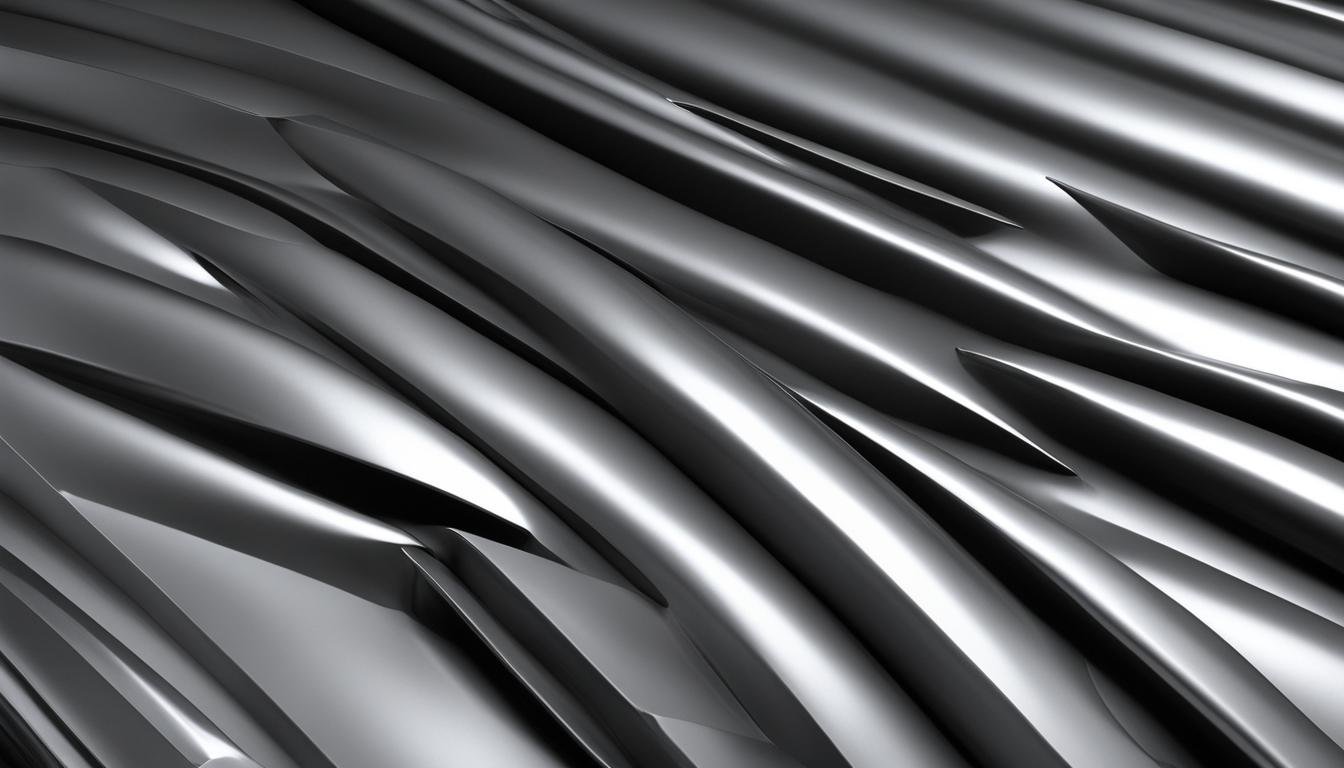When it comes to machining processes, turning and milling are two essential techniques used in the manufacturing industry. While both methods involve removing material from a workpiece, they differ in several aspects, including their approach, tooling, applications, and cutting direction.
In this article, we will delve into the dissimilarities between turning and milling surface finish, equipping you with the knowledge to make informed decisions in your mechanical projects.
Key Takeaways:
- Turning and milling are distinct machining processes with their own characteristics and applications.
- Turning involves rotating the workpiece while a stationary cutting tool removes material.
- Milling utilizes a rotating multi-point cutting tool to remove material from a stationary or moving workpiece.
- Turning is commonly used for cylindrical or conical-shaped workpieces, while milling offers versatility in shape creation.
- The tooling and cutting direction vary in turning and milling, leading to differences in surface finish.
Understanding Turning
Turning is a fundamental machining process that involves rotating the workpiece while a stationary cutting tool removes material. It is frequently used to create cylindrical or conical-shaped workpieces, making it an essential technique in various industries.
One of the key features of turning is the use of single-point cutting tools mounted on a tool holder. These tools have a single cutting edge, allowing for precise and controlled material removal. The cutting direction in turning is parallel to the axis of rotation, resulting in material being cut along the radial direction of the workpiece.
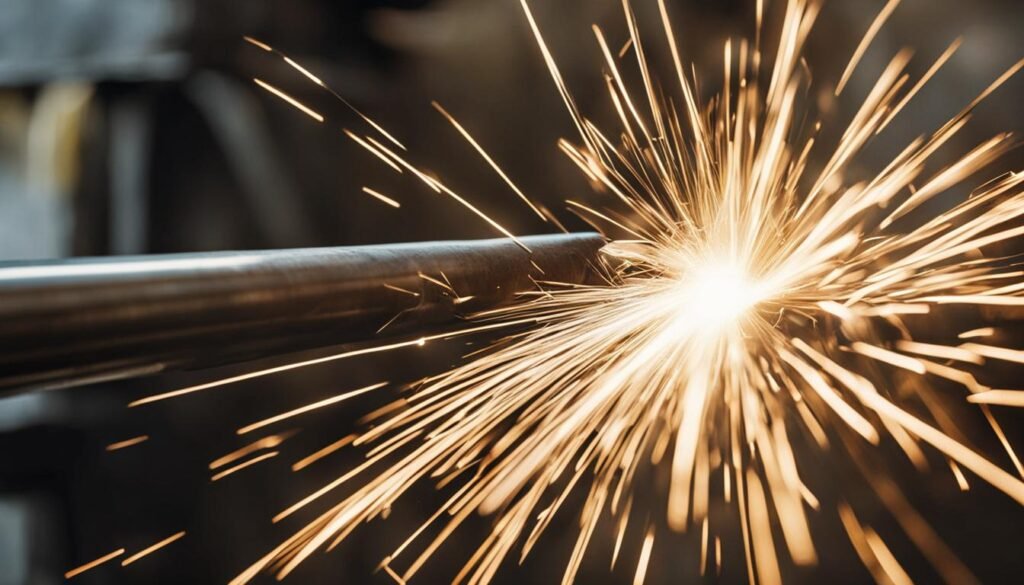
Turning is ideal for creating precise and symmetrical shapes, which is why it is commonly used in manufacturing industries. The cylindrical and conical shapes produced through turning are essential for components like shafts, spindles, and cylindrical surfaces.
Overall, turning provides manufacturers with an efficient and accurate method for shaping workpieces. It offers the advantage of using single-point cutting tools and a defined cutting direction, ensuring high-quality results and meeting the specific requirements of different machining applications.
Exploring Milling
Milling is a versatile machining operation that involves removing material from a stationary or moving workpiece using a rotating multi-point cutting tool. This process offers a wide range of applications and allows for the creation of various shapes and features, making it a popular choice in industries such as aerospace, automotive, and consumer electronics.
One of the key advantages of milling is its ability to create complex 3D geometries. This is achieved by the tool’s movement along multiple axes, including the X, Y, and Z axes. With this freedom of movement, milling can produce not only flat surfaces but also slots, pockets, contours, and intricate shapes with high precision.
The cutting direction in milling differs from turning. In milling, the cutting tool moves in a combination of linear and rotational motions. This dynamic movement allows for efficient material removal, especially when dealing with harder materials or when a high material removal rate is required.

Advantages of Milling:
- Creates complex 3D geometries
- Allows for the production of slots, pockets, and contours
- High precision in shape creation
- Efficient material removal
Overall, milling is a versatile machining process that offers a wide range of applications and shape creation capabilities. Whether you need to produce intricate 3D geometries or require efficient material removal, milling is a reliable choice for achieving your desired outcomes.
Applications of Turning
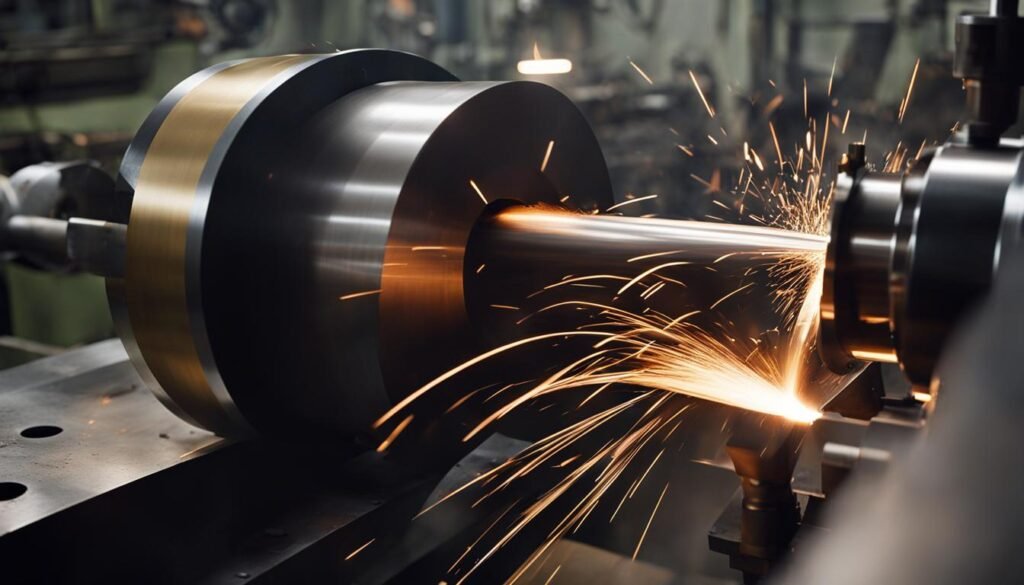
Turning is a versatile machining process that finds applications in various industries. Its ability to create cylindrical and conical workpieces makes it ideal for a wide range of manufacturing needs. Here are some common applications of turning:
Cylindrical Workpieces
One of the primary applications of turning is the production of cylindrical workpieces. Turning allows manufacturers to create shafts, spindles, and other cylindrical components with precision. The rotational motion of the workpiece and the parallel cutting direction ensure consistent and accurate shaping.
External Turning
External turning is the process of removing material from the outer surface of a workpiece. It is widely used in the manufacturing of components like flanges, bushings, and bearing races. By employing various cutting tools and techniques, external turning enables manufacturers to achieve the desired dimensions, surface finish, and tight tolerances on the external surfaces of the workpiece.
Internal Turning
Internal turning involves the removal of material from the internal surfaces of a workpiece. This process is commonly used in the production of bores, holes, and internal threads. With the right cutting tools and techniques, internal turning allows for the creation of precise and accurate internal features, ensuring a proper fit with mating components.
In summary, turning is a versatile machining process with applications in the production of cylindrical workpieces, external components, and internal features. Its ability to create accurate dimensions and achieve desired surface finishes makes it a popular choice in various industries.
Applications of Milling
Milling is a versatile machining process that finds wide applications in various industries. It is valued for its ability to create complex shapes and features on different workpiece geometries. Let’s explore some of the key applications of milling:
1. Versatile Shape Creation
Milling is highly regarded for its versatility in shape creation. It can produce a wide range of features such as flat surfaces, slots, pockets, contours, and intricate 3D geometries. This makes milling an essential process in industries like aerospace, automotive, and consumer electronics, where complex and precisely machined parts are required.
2. Surface Finishing
Milling can also be used for surface finishing operations. Depending on the cutting tool and techniques employed, milling can produce smooth surfaces or add texture to the workpiece. This makes it suitable for applications that require specific surface finish requirements, such as medical devices and decorative components.
Overall, the flexibility and adaptability of milling make it a crucial machining operation in modern manufacturing. Its ability to create intricate shapes and achieve desired surface finishes make it an indispensable process in various industries.
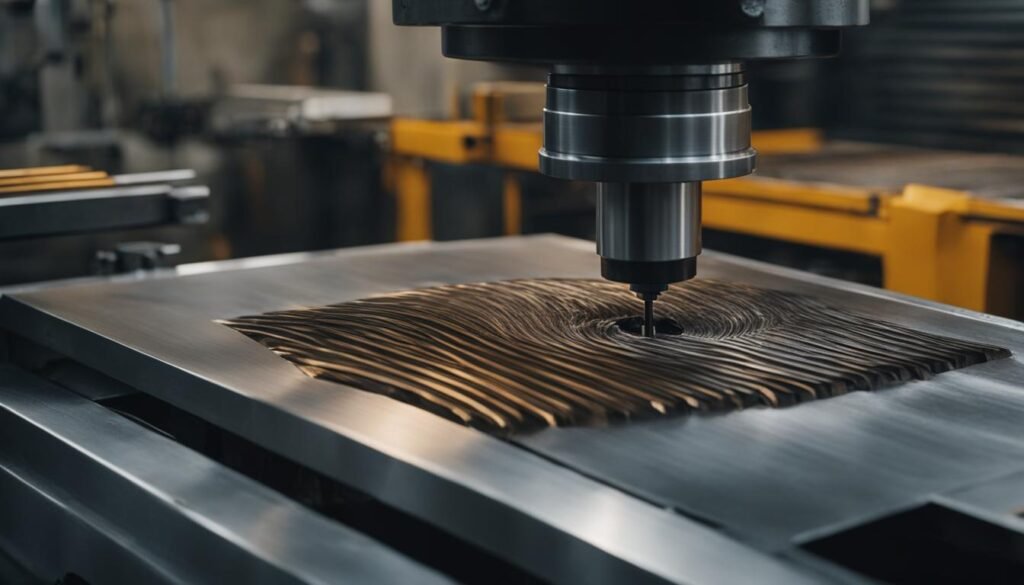
| Industry | Applications |
|---|---|
| Aerospace | Producing aircraft parts with complex geometries and precision |
| Automotive | Manufacturing engine components, gearbox parts, and steering components |
| Medical Devices | Creating intricate surgical instruments and implants with precise dimensions |
| Consumer Electronics | Producing casings, connectors, and other intricate components |
Differences in Tooling
When it comes to tooling, turning and milling rely on different types of cutting tools. Turning primarily utilizes single-point cutting tools, such as lathe tools, mounted on a tool holder. These tools have a single cutting edge that engages with the workpiece to remove material. They are commonly used in turning operations to shape cylindrical or conical workpieces. Single-point cutting tools are versatile and can be easily sharpened or replaced when necessary.
On the other hand, milling employs multi-point cutting tools, such as end mills or face mills. These tools feature multiple cutting edges that work together to remove material from the workpiece. Multi-point cutting tools allow for more complex shaping and machining operations, including the creation of flat surfaces, slots, contours, and intricate 3D geometries. However, unlike single-point cutting tools, multi-point cutting tools are more expensive and require regular maintenance to ensure optimal performance.
In summary, turning relies on single-point cutting tools, while milling utilizes multi-point cutting tools. Each type of tooling offers its unique advantages and considerations in terms of cost, versatility, and maintenance. Manufacturers must carefully consider the specific requirements of their machining projects and choose the appropriate tooling for the desired outcome.
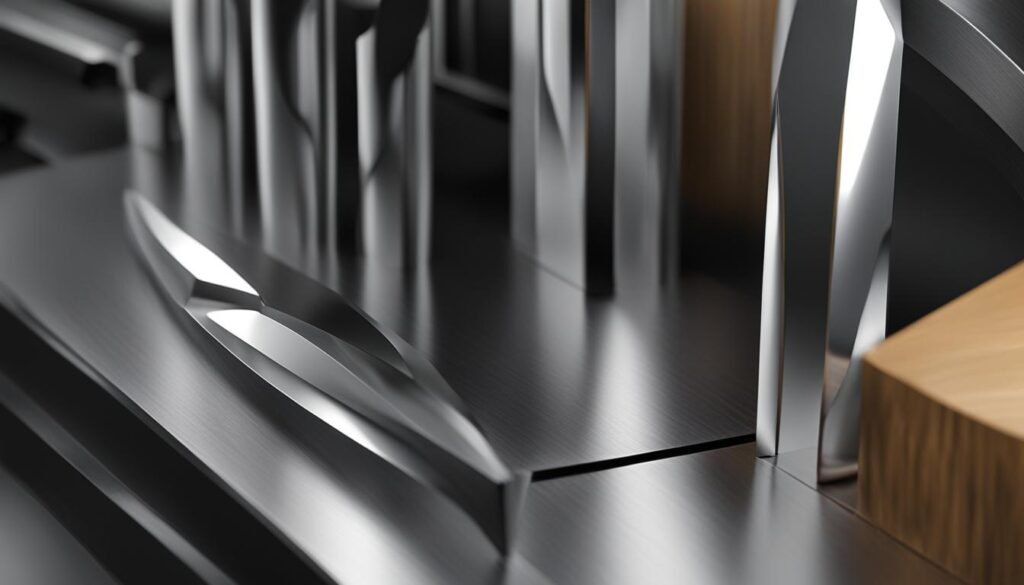
Variations in Cutting Direction
When it comes to the cutting direction in turning and milling, there are distinct differences between the two machining processes. In turning, the cutting tool moves parallel to the axis of rotation of the workpiece. This results in material removal along the radial direction, as the tool engages with the workpiece. This cutting direction allows for the creation of cylindrical or conical-shaped workpieces with precision.
On the other hand, milling involves a more complex cutting direction. The cutting tool in milling moves in a combination of linear and rotational motions along multiple axes. These axes, including the X, Y, and Z axes, allow for the creation of intricate and complex shapes and contours. The ability to move along multiple axes makes milling a versatile process for producing parts with diverse geometries.
Understanding the variations in cutting direction is crucial in selecting the appropriate machining process for a given application. If you require cylindrical or conical-shaped workpieces, turning with its parallel cutting direction is the ideal choice. But if your project involves complex shapes and contours that require movement along multiple axes, milling can deliver the desired results effectively.
Surface Finish Differences
When it comes to surface finish, turning and milling processes offer distinct results. Turning generally produces smoother surface finishes, thanks to the continuous tool engagement along the radial direction. On the other hand, milling provides the versatility to achieve both smooth surfaces and unique textures, depending on the cutting tool and techniques used.
In turning, the cutting tool moves parallel to the axis of rotation of the workpiece, resulting in material removal along the radial direction. This continuous cutting action allows for consistent contact with the workpiece, resulting in a smoother surface finish. The single-point cutting tool used in turning ensures that there is minimal variation in cutting forces, leading to improved surface quality.
Milling, on the other hand, offers the ability to create a variety of surface finishes. While it is capable of producing smooth surfaces similar to turning, milling can also be used to add texture or create unique surface finishes. By employing different cutting tools and techniques, such as using ball-end mills for contouring or textured cutters for creating intricate patterns, milling can achieve visually appealing surface finishes with added depth and complexity.
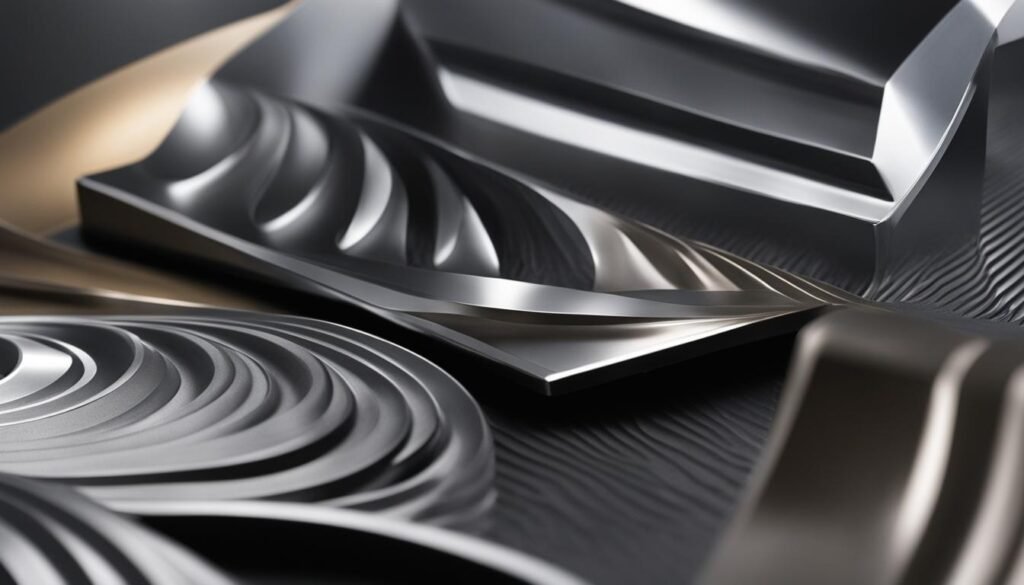
Overall, the choice between turning and milling for achieving the desired surface finish depends on the specific requirements of the project. If a smooth, consistent surface finish is the primary goal, turning may be the preferred option. However, if there is a need for added texture or unique surface finishes, milling provides the versatility and flexibility to meet these requirements.
Choosing the Right Process
When it comes to machining, choosing between turning and milling can significantly impact the outcome of your project. To make the right decision, you need to consider several factors, including your specific machining requirements and the geometry of the workpiece.
First, assess your machining requirements. Determine the level of accuracy you need to achieve, the surface finish desired, and any additional features or specifications required. Turning and milling have their unique strengths, and selecting the appropriate process ensures that you can meet your project’s demands effectively.
Next, consider the geometry of the workpiece. Turning is well-suited for cylindrical or conical shapes, making it ideal for creating shafts, spindles, and other similar components. On the other hand, milling offers greater versatility, allowing you to produce a wide range of shapes, contours, and surface finishes.
By carefully evaluating your machining requirements and workpiece geometry, you can make an informed decision between turning and milling. Remember, each process has its advantages, and understanding their differences is crucial in selecting the most suitable method for your specific needs.
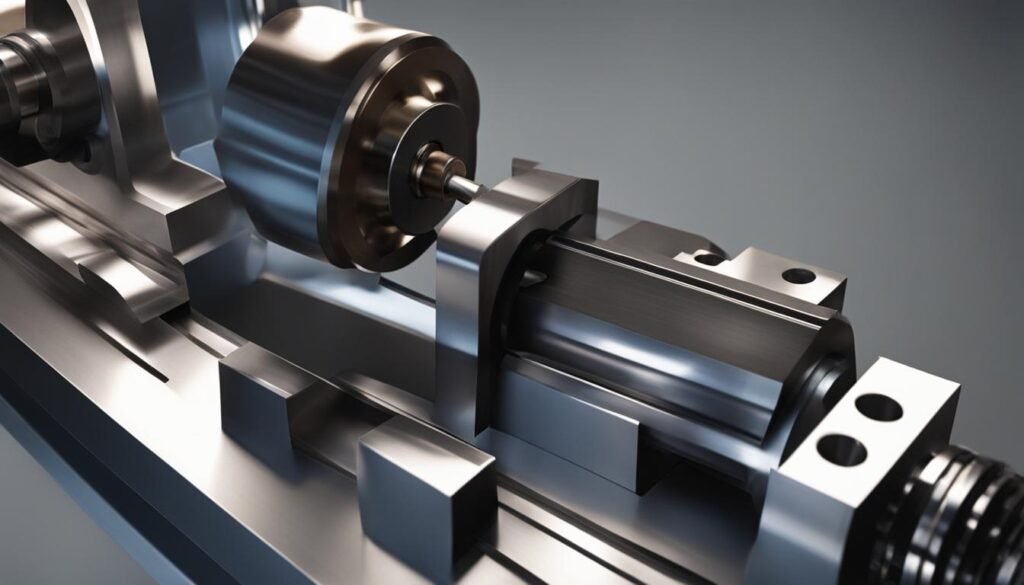
Conclusion
In conclusion, when it comes to achieving the desired surface finish, both turning and milling have their unique advantages. Turning is the go-to process for creating cylindrical or conical workpieces. It offers smooth surface finishes due to continuous tool engagement along the radial direction. On the other hand, milling provides more versatility in shape creation, making it suitable for a wide range of workpiece geometries. With milling, you can achieve not only smooth surfaces but also add texture or create different surface finishes based on your cutting tool and techniques.
When deciding between turning and milling, consider your specific machining requirements and the desired part geometry. If you need cylindrical or conical workpieces, turning is the ideal choice. However, if you require complex geometries or want more design flexibility, milling is the way to go. By understanding the differences and applications of these two machining processes, you can make informed decisions to achieve the surface finish you desire for your mechanical projects.
To summarize, turning and milling are distinct processes with their own strengths. Turning excels in creating cylindrical or conical workpieces, while milling offers versatility and shape creation options. Whether you prioritize smooth finishes or need to add texture, choosing the right process depends on your specific needs and desired surface finish. So, select the machining method that aligns with your requirements to achieve exceptional results in your projects.
FAQ
What is the difference between turning and milling surface finish?
Turning and milling are two distinct machining processes that differ in their approach to removing material from a workpiece. In turning, the workpiece is rotated while a stationary cutting tool removes material along the radial direction, resulting in smoother surface finishes. Milling, on the other hand, uses a rotating multi-point cutting tool to remove material with a combination of linear and rotational motions along multiple axes, offering versatility in shape creation.
How does turning work?
Turning is a machining process where the workpiece is rotated while a stationary cutting tool removes material. It is commonly used to create cylindrical or conical-shaped workpieces. Turning utilizes single-point cutting tools mounted on a tool holder, and the cutting direction is parallel to the axis of rotation.
What are the applications of turning?
Turning is commonly used to create cylindrical or conical-shaped workpieces such as shafts, spindles, and cylindrical surfaces. It is also suitable for external turning, which refers to removing material from the outer surface of the workpiece, and internal turning, which involves removing material from internal surfaces.
How does milling work?
Milling is a machining process where a rotating multi-point cutting tool removes material from a stationary or moving workpiece. It offers versatility in creating different shapes and features, including flat surfaces, slots, pockets, contours, and complex 3D geometries. Milling allows the cutting tool to move along multiple axes, enabling the creation of intricate shapes and contours.
What are the applications of milling?
Milling is known for its versatility in creating different shapes and features. It is commonly used in industries like aerospace, automotive, medical devices, and consumer electronics to produce parts with complex geometries. Milling can also be used for surface finishing operations, creating smooth surfaces or adding texture.
What are the differences in tooling between turning and milling?
Turning primarily utilizes single-point cutting tools, such as lathe tools, mounted on a tool holder. On the other hand, milling employs multi-point cutting tools, such as end mills or face mills. Single-point cutting tools have a single cutting edge, while multi-point cutting tools have multiple cutting edges.
How does the cutting direction differ in turning and milling?
In turning, the cutting tool moves parallel to the axis of rotation of the workpiece, resulting in material removal along the radial direction. In milling, the cutting tool moves in a combination of linear and rotational motions along multiple axes, including the X, Y, and Z axes.
How does surface finish differ between turning and milling?
Turning generally produces smoother surface finishes due to continuous tool engagement along the radial direction. Milling can also achieve smooth surfaces but can also be used to add texture or create different surface finishes depending on the cutting tool and techniques used.
How do I choose the right machining process between turning and milling?
Choosing between turning and milling depends on factors such as the desired part geometry and complexity, material type, required machining accuracy, and specific machining requirements. Understanding the differences between these processes helps manufacturers select the most appropriate method for their specific needs.
Source Links
- https://www.estoolcarbide.com/article/what-is-the-difference-between-turning-and-milling–newsinfo-37.html
- https://www.sundicuttingtools.com/news/technology-articles/what-is-the-difference-between-cnc-turning-and-milling/
- https://at-machining.com/difference-between-precision-cnc-milling-and-turning-machining/
